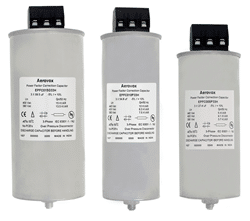source: Aerovox news
New Bedford, MA (PRWEB)April 20, 2017
Aerovox Corp., a worldwide market leader in film capacitors has developed a class of rugged and long lasting power factor correction capacitors (PFCs) purposely designed for 50 Hz applications. These substantially improve performance over competitive offerings.
PFC capacitors help filter the harmonics load in an electric power system, which allows more efficient usage of the utility power and reduces the amount of current lost. More useful power is transferred to the power system without requiring larger wiring or more robust equipment. Use of PFC capacitors in industrial or manufacturing settings results in significant cost savings and longer equipment life. The efficient use of power also means the utility grid can avoid building additional power generators, saving the capital cost, specifically in emerging markets. 50 Hz PFC capacitors are used in most of the world with the exception of North America, some of South America and Japan where 60 Hz is standard.
Aerovox’s new PFC capacitors are manufactured to the same stringent design guidelines as its well-regarded 60 Hz PFCs, but were purpose built for 50 Hz applications. By providing pinpoint design for 50 and 60 Hz applications Aerovox PFC capacitors provide higher overall efficiency and performance.
Because the Aerovox 50 Hz PFC capacitors were developed from a 60 Hz platform, they are more robust and can take more current on a given voltage rating than other competitive products. If a power system is receiving “dirty” power (fluctuations, harmonic dissonance, etc.) the Aerovox PFC capacitor can filter these out and the capacitor will not fail. In fact, Aerovox capacitors are manufactured with built-in self-healing properties. The elements are wound on fully automatic numerically controlled winding machines which ensure no corona discharge or ionization.
These new capacitors meet the reliability requirements of 50 Hz customers including IEC 60831-1 & 2and IS :13340 PART 1 & 2 as well as CE compliance standards. They are available for immediate shipment.
Aerovox 50 Hz capacitors are customizable, including custom ratings and terminal options. They are available in a wide range of configurations including high harmonic, voltage and KVAR ranges.
“Durability is an important factor in PFC applications,” said Jim Faughnan, Aerovox President and CEO. “That’s why we designed these 50 Hz bulletproof capacitors for our customers in the 50 Hz world for whom power load improvement is critical. But durability is not the only value our new 50 Hz PFC capacitors offer, as they are easily customized to any application.”
Aerovox 50 Hz PFC capacitors are manufactured in its state-of-the-art facility in Hydrabad, India under an ISO 9001-certified quality management system. They are 100% tested prior to shipment, and test data is retained for five years for complete traceability by individual work order numbers.
































